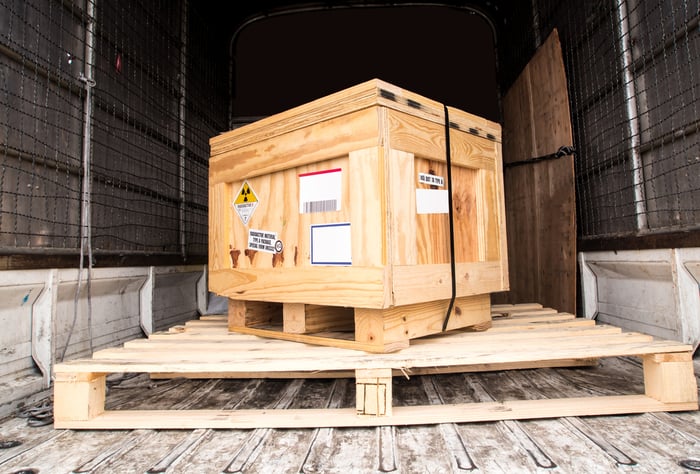
Expert Advice: Ensure DG Compliance with Accurate Shipping Labels
Did you know that pistachios can be considered hazardous in certain shipping circumstances? We did not! Meet Kristen Dapore, Director of Business Strategy for LabelMaster, who will walk us through the following:
- HAZMAT/Dangerous goods (DG) shipping challenges
- How to keep up with DG regulations
- Unexpected HAZMAT products/goods
Let’s jump right into it!

The More You Know, the Safer the World Will Be
Get to Know Kristen Dapore!
Q: Tell us about yourself. How did you get to where you are today? How long have you been in the Dangerous Goods/HAZMAT industry?
Dapore: I have a background in business administration from University of North Carolina (Go Tarheels!). I then spent a few years in healthcare consulting, working to help hospitals optimize their processes and provide performance improvement solutions. For the past 12 years, I have been focused on the DG industry with LabelMaster helping to grow and develop the business.
Top Two DG/HAZMAT Shipping & Compliance Challenges
Q: What challenges do you see shippers face when it comes to HAZMAT/DG compliance?
Dapore: I think the biggest challenge we see is first understanding what products you have that are considered hazardous. You must understand what's in your warehouse, and there is a wide variety of goods that are classified as dangerous goods. The average consumer doesn’t necessarily know or understand that, especially those in the retail industry that ship smaller quanties.
Staying current with the HAZMAT regulations is the next biggest challenge. Some of the regulations change once a year and others even up to four times a year, depending on the governing body who publishes those rules. Not to mention, things can get super confusing if you’re shipping internationally.
How to Keep Up with HAZMAT/DG Regulations
Q: HAZMAT and dangerous goods regulations are constantly changing. What should shippers do to adapt?
Dapore: Staying connected to the industry is the key, whether that be an internal resource or hiring it out externally through a partner like LabelMaster. There's a lot of ways to do this, like being a part of forum groups or following the governing bodies via email or social media to stay in touch with what they're up to. Typically these changes don’t hit the highlights in your news feed, soit's just really being connected with the industry so you can stay in compliance.
The US regulatory body publishes weekly changes. It can be really dry, so our blogs help break this down into bite-size chunks that people can get that information and go on with their day.
We also offer resources to help bridge the knowledge gap. You can call our 1-800 number to ask any of your questions. It's for anyone, not just our customers. We can assist with answering questions around your products or shipments, and pointing you to the correct regulations to get you on the right track.
We get inbound questions from all kinds of sources, and we'll treat you all the same whether you’re a customer or not. For more complex issues, we have a complete services team that you can purchase consultation hours from if you’re looking for assistance such as product classification, compliance audits, workflow best practices, etc..
LabelMaster’s Quest for a Safer World
Q: What are LabelMaster's vision and mission? What does your company provide to shippers?
Dapore: Our mission is taking the complexity out of dangerous goods transportation to make the world a safer place. It's a very niche market, but everyone at LabelMaster does believe in this, and that's why our resources are readily available. We want people to do DG shipping in a safe manner. We cannot prevent an incident, but we can ensure everything is properly identified and marked for first responders to understand and know how to appropriately respond to the situation.
One of the purposes for DG regulations is to give first responders an insight into what they're dealing with. The communication of HAZMAT, including iconography, colors, and symbols, are crucial to those on the front lines to know what they're walking into.
When we say we’re trying to make the world a safer place, we truly believe it! It’s what we do, and it very much has an impact on the world.
.png?width=700&name=MicrosoftTeams-image%20(4).png)
Fun Facts! Unexpected but Hazardous Goods
Q: What are some unexpected products that are considered hazardous?
Dapore: Pistachios! And it's only in certain circumstances that can be considered explosive. If they're stacked in too large of a volume and there’s not enough ventilation, they give out enough gas that can be ignited. Individually packed pistachios are fine, but a bulk delivery in a cargo van can ignite.
There are common products like perfumes, nail polish, and aerosol cans. Right now, the big thing is lithium batteries, and this just means it's rechargeable battery. Milk is also one—it’s a marine pollutant and could kill animals within the waterways. Cinnamon is an inhalant, so it could suffocate you if it's in large quantities.
One product that people don’t think about is a seatbelt pretensioner. When you yank your seatbelt and it stops, that’s the seatbelt pretensioner. This is considered an explosive if it’s engaged when you’re transporting them.There are many parts within a car can be considered hazardous.
I could keep going….A lot of things can be considered a dangerous good depending on the shipping circumstance, like mode of transportation and volume of those goods.
LabelMaster's Motivation for Better
Q: What's new with LabelMaster? What are you and your company currently excited by?
Dapore: Every company is trying to become more efficient and streamlined in their workflows with less personnel. So, for us, we're excited to partner with companies like ShipERP to be the backend into these DG processes and help achieve these efficiencies with stacked automation.
Helping to get the word out there that what you're doing might be dangerous and regulated. And we're here to help. We get new customers every single day, and that’s exciting to see for us because we’re reaching more people who are going to ship dangerous goods correctly, and the world is just a little safer. That’s what gets us up in the morning, and that’s what drives us to do better every day.
ShipERP’s HAZMAT Resources
Automate Your HAZMAT/DG Shipping Processes with ShipHAZ
Kick start your HAZMAT shipping automation with our hazardous material compliance solution: ShipHAZ. Transporting hazardous goods can be tricky to navigate, especially with countless laws and regulation. Luckily, ShipHAZ eliminates unnecessary steps from your HAZMAT shipping process to streamline your supply chain. Thanks to the automation enabled by ShipHAZ, you can avoid legal fines as high as $100,000!
Sign up today for a FREE demo of ShipERP’s hazardous material compliance solution.
More HAZMAT/DG Content
Want to know more about HAZMAT shipping and compliance? Check out the following downloadable content and blogs to learn more:
- Quick Guide to Shipping Hazardous Materials
- 6 Common HAZMAT Goods: What are Hazardous Materials?
- [Infographic] Ship Your HAZMAT Goods with Confidence
- How Do Major Carriers Conduct DG Shipping?
- Helpful Tips for DG Shipping
- The Basics of the Shipper’s Declaration for Dangerous Goods
- [Checklist] HAZMAT Goods Cheat Sheet for Logistics
- 4 Things IATA Wants You to Know About HAZMAT Shipping


